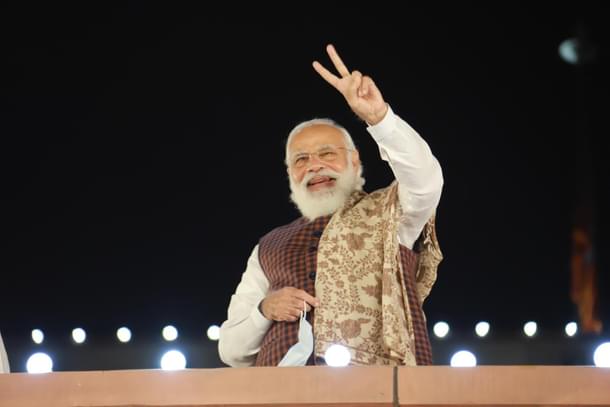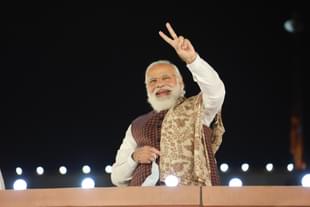Politics
What Victories In Bihar And Other Bypolls Mean For The BJP
Aashish Chandorkar
Nov 12, 2020, 01:43 AM | Updated 01:43 AM IST
Save & read from anywhere!
Bookmark stories for easy access on any device or the Swarajya app.


Bihar state elections seem to be acquiring a reputation for slaying pollsters. In 2015 and in 2020, several reputations have been dented with incorrect predictions, though in opposite directions. But there’s one consensus which has emerged from the Bihar results and the bypolls around the country: Prime Minister (PM) Narendra Modi operates in his own league with Indians trusting him – intentions, actions and words alike.
To be sure, neither the Bihar election nor the bypolls were fought on national issues per se. But these polls came in the backdrop of the ongoing Covid-19 pandemic.
Indian government response to the pandemic has been very conservative and the initial choice of “lives over livelihood” was very clear. This has led to the ongoing criticism from the Opposition. Of course, the Opposition would have criticised the pandemic strategy even if the decisions taken were exactly opposite.
But what came out in the results on Tuesday was that people at large did not show any particular dissatisfaction with the national Covid-19 response with their voting decision. Furthermore, close inspection of the Bihar data suggests that the National Democratic Alliance (NDA) only won with a Modi-boost sweeping in the second and third phases of the election.
After a poor showing in phase 1, where NDA won just 29 per cent of the seats, the Modi factor seems to have changed things.
In phase 2 and phase 3, the NDA had a strike rate of 56.3 percent and 73.7 per cent in the constituencies he addressed a rally (Source: Roshan Kishore, Twitter). The NDA won 52 per cent of the seats in the second phase and 67 per cent of the seats in the third phase.
The relentless focus of the Modi government in designing welfare programmes with women at the centre of the decision making, seems to continue paying dividends for the Bharatiya Janata Party (BJP).
As per an analysis conducted by Hindustan Times, seats which had the highest turnout of women had a disproportionate win rate for the NDA constituents.
This analysis suggests that the 62 per cent of the seats which featured in top 20 per cent seats by women voter turnout were won by the NDA. In the bottom 20 per cent seats by women turn out, NDA won only 24 per cent of the seats.
In fact, women outnumbered men in voting this year in Bihar. The turnout amongst men was 54.7 per cent while the women turn out was almost 60 per cent.
It appears that more women voted and voted for the NDA as the campaign message of ‘jungle raj returns’ caught on.
In fact Axis My India, the campaign agency which called Bihar wrong despite having a stellar prediction record starting with Bihar 2015, released a statement on Twitter saying this was precisely the trend they misread in their calculations.
Then there’s the story of Lok Janshakti Party (LJP) chief Chirag Paswan – the 'Hanuman to the Lord Ram of Narendra Modi'. He curiously decided to contest alone, breaking away from the NDA and trained his guns on Chief Minister (CM) Nitish Kumar.
His candidates got more votes than the margin of loss of 32 NDA candidates, including 27 candidates of Janata Dal United (JDU). His candidates also spoiled the party for 31 Mahagathbandhan candidates.
In the net analysis, he helped the Mahagathbandhan more than the NDA, even if it was a difference of only one seat. Was he deployed by the BJP to absorb some of the anti-incumbency votes? The data does not necessarily corroborate that hypothesis, but of course we may never know.
Similarly, the All India Majlis-e-Ittehad-ul-Muslimeen bagged five seats, prompting national commentary on a break in secular ranks. This was hotly contested by the party chief Asaduddin Owaisi. Without his candidates, the Mahagathbandhan would have won those five seats, but he wasn’t the reason for the loss of any other Mahagathbandhan candidates, barring a couple.
Perhaps, there wasn’t much of a conspiracy theory in LJP and AIMIM going their own ways and perhaps the parties were just looking after their own interests. But Occam’s Razor is seldom appealing in Indian politics.
The Bihar result also came in as a shot in the arm for Devendra Fadnavis, ex-CM of Maharashtra. He was the BJP campaign in-charge for the state. After losing Maharashtra last year in post-poll manoeuvres, this election was a test for him too, which he passed in flying colours.
Beyond Bihar too, the BJP scored key victories.
In Madhya Pradesh, the party won 19 out of the 28 bypolls, settling comfortably in the government. With 12 per cent of the state’s total legislature going to bypolls, this was a mini election of sorts. The party comfortably won getting just under 50 per cent of the total votes. This will stabilise the Shivraj Singh government in the state and clears the path of Jyotiraditya Scindia to settle in the party and get greater responsibilities.
Another boost came in Uttar Pradesh where the BJP won six of the seven seats, with the seventh seat being a Samajwadi Party (SP) stronghold.
Despite the recent controversies around law and order, the party scored almost 37 per cent vote in a four-corner contest, with all its six candidates winning by big margins. This will help CM Yogi Adityanath with the state polls only fifteen months away.
The BJP also won both seats in Karnataka, all the four it contested in Manipur and all eight in Gujarat, further strengthening its base in the state legislatures.
There have been calls for Nitish Kumar to go back to Mahagathbandhan and endorse Tejashwi Yadav as the CM. Will Nitish repeat the short-lived alignment from 2015 or will he serve his last term as the CM as he said on the last day of election campaign?
That suspense still continues.
Just before the third phase of Bihar polls, PM Modi wrote a letter to the Bihar electorate. The letter was an appeal to the voters to choose governance and development one more time. He offered the ‘double engine’ option, effectively trying to negate the Nitish Kumar fatigue.
There was no Prime Ministerial insignia on the letter. It was a personal gesture. It seems the voters of Bihar did listen to him.
Aashish Chandorkar is Counsellor at the Permanent Mission of India to the World Trade Organization in Geneva. He took up this role in September 2021. He writes on public policy in his personal capacity.





